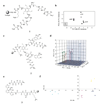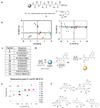A general approach to differential sensing using synthetic molecular receptors
- PMID: 20801075
- PMCID: PMC2997874
- DOI: 10.1016/j.cbpa.2010.07.022
A general approach to differential sensing using synthetic molecular receptors
Abstract
Differential sensing is continuing to develop as an alternative to traditional, selective chemosensing techniques. This technique takes a cue from how the human senses of taste and smell operate in order to obtain qualitative and even quantitative data on single analytes and mixtures. Whereas classical chemosensing techniques inspired by the 'lock-and-key' approach depend on the development of a selective receptor for a target analyte, pattern-based sensing depends on the development of an array of cross-reactive receptors, which produce a collection of responses upon the array's interaction with a target analyte. This review focuses on an approach to differential sensing that diversifies synthetic receptors to be used in an array via appending combinatorial peptidic arms, metal ions, and indicators to a core binding unit.
Copyright © 2010 Elsevier Ltd. All rights reserved.
Figures




Similar articles
-
Sensing A Paradigm Shift in the Field of Molecular Recognition: From Selective to Differential Receptors.Angew Chem Int Ed Engl. 2001 Sep 3;40(17):3118-3130. doi: 10.1002/1521-3773(20010903)40:17<3118::AID-ANIE3118>3.0.CO;2-Y. Angew Chem Int Ed Engl. 2001. PMID: 29712042 Review.
-
Differential receptor arrays and assays for solution-based molecular recognition.Chem Soc Rev. 2006 Jan;35(1):14-28. doi: 10.1039/b505518k. Epub 2005 Nov 7. Chem Soc Rev. 2006. PMID: 16365639 Review.
-
Activity-Based Sensing: A Synthetic Methods Approach for Selective Molecular Imaging and Beyond.Angew Chem Int Ed Engl. 2020 Aug 10;59(33):13734-13762. doi: 10.1002/anie.201909690. Epub 2020 Apr 23. Angew Chem Int Ed Engl. 2020. PMID: 31605413 Free PMC article. Review.
-
Engineering Aspects of Olfaction.In: Persaud KC, Marco S, Gutiérrez-Gálvez A, editors. Neuromorphic Olfaction. Boca Raton (FL): CRC Press/Taylor & Francis; 2013. Chapter 1. In: Persaud KC, Marco S, Gutiérrez-Gálvez A, editors. Neuromorphic Olfaction. Boca Raton (FL): CRC Press/Taylor & Francis; 2013. Chapter 1. PMID: 26042329 Free Books & Documents. Review.
-
The ongoing search for small molecules to study metal-associated amyloid-β species in Alzheimer's disease.Acc Chem Res. 2014 Aug 19;47(8):2475-82. doi: 10.1021/ar500152x. Epub 2014 Jul 31. Acc Chem Res. 2014. PMID: 25080056
Cited by
-
Differential Sensing of Saccharides Based on an Array of Fluorinated Benzosiloxaborole Receptors.Sensors (Basel). 2020 Jun 22;20(12):3540. doi: 10.3390/s20123540. Sensors (Basel). 2020. PMID: 32580489 Free PMC article.
-
Predicting the composition of red wine blends using an array of multicomponent Peptide-based sensors.Molecules. 2015 May 20;20(5):9170-82. doi: 10.3390/molecules20059170. Molecules. 2015. PMID: 26007178 Free PMC article.
-
DNA-polyfluorophore Chemosensors for Environmental Remediation: Vapor-phase Identification of Petroleum Products in Contaminated Soil.Chem Sci. 2013 Aug 1;4(8):3184-3190. doi: 10.1039/C3SC50985K. Chem Sci. 2013. PMID: 23878719 Free PMC article.
-
RNA Structural Differentiation: Opportunities with Pattern Recognition.Biochemistry. 2019 Jan 29;58(4):199-213. doi: 10.1021/acs.biochem.8b01090. Epub 2018 Dec 18. Biochemistry. 2019. PMID: 30513196 Free PMC article. Review.
-
In-situ generation of differential sensors that fingerprint kinases and the cellular response to their expression.J Am Chem Soc. 2013 Oct 2;135(39):14814-20. doi: 10.1021/ja407397z. Epub 2013 Sep 18. J Am Chem Soc. 2013. PMID: 23991633 Free PMC article.
References
-
-
Anslyn EV. Supramolecular analytical chemistry. J. Org. Chem. 2007;72:687–699. Discusses principles behind array sensing using supramolecular sensors and applications of array sensing for quantitative analysis.
-
-
- Wright AT, Anslyn EV. Differential receptor arrays and assays for solution-based molecular recognition. Chem. Soc. Rev. 2006;35:14–28. - PubMed
-
- Collins BE, Wright AT, Anslyn EV. Combining molecular recognition, optical detection, and chemometric analysis. Top. Curr. Chem. 2007;277:181–218.
-
- Albert KJ, Lewis NS, Schauer CL, Sotzing GA, Stitzel SE, Vaid TP, Walt DR. Cross-reactive chemical sensor arrays. Chem. Rev. 2000;100:2595–2696. - PubMed
-
-
Eriksson L, Johansson E, Kettaneh-Wold N, Trygg J, Wikström C, Wold S. Multi- and Megavariate Data Analysis Part I: Basic Principles and Applications. edn 2nd. Umetrics AB: Umeå; 2006. Presents an easy to understand graphical explanation and applications of principal component analysis.
-
Publication types
MeSH terms
Substances
Grants and funding
LinkOut - more resources
Full Text Sources
Other Literature Sources

